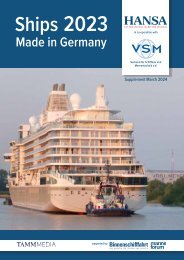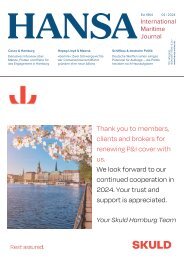HANSA 06-2019
Reparatur & Umbau | Start-Ups | COMPIT Review | CIMAC 2019 | Terminaltechnik | Batterien & Hybrid | Offshore-Flotte | U.A.E. | Cruise Ship Interiors | Zeaborn & Offen
Reparatur & Umbau | Start-Ups | COMPIT Review | CIMAC 2019 | Terminaltechnik | Batterien & Hybrid | Offshore-Flotte | U.A.E. | Cruise Ship Interiors | Zeaborn & Offen
Erfolgreiche ePaper selbst erstellen
Machen Sie aus Ihren PDF Publikationen ein blätterbares Flipbook mit unserer einzigartigen Google optimierten e-Paper Software.
Schiffstechnik | Ship Technology<br />
The Italian way for cuise interior logistics<br />
To guarantee efficient shipbuilding at cruise shipyards, logistics for interior design is key.<br />
Fincantieri group relies on its own production affiliate and combines land-based and<br />
maritime transport, writes Michael Meyer<br />
The 100% subsidiary »Marine Interiors«<br />
was established in 2014 to enable<br />
the group, whose cruise ship newbuilding<br />
facilities are located predominantly<br />
in Italy and through its subsidiary Vard<br />
in Norway, to integrate cabin design and<br />
production into its design and construction<br />
flow.<br />
German competitor Meyer Werft is<br />
well-known for its »blockbuilding construction«<br />
with prefabricated hull sections<br />
as well as for its longstanding and<br />
deep cooperation with a huge number of<br />
regional suppliers. The shipyard group<br />
MV Werften which is also located in Germany<br />
has gone its own way, too, when<br />
setting up a cabin production facility in<br />
2016. As completely pre-assembled modules,<br />
the cabins are delivered to the yards<br />
and installed there.<br />
At Fincantieri, Marine Interiors focuses<br />
on designing, refitting and delivering<br />
turnkey cabins, in the fields of both newbuilding<br />
and refurbishment. The factory<br />
for interiors is located in Pordenone between<br />
the shipyards in Monfalcone and<br />
Marghera.<br />
In February, Fincantieri delivered the<br />
first vessels designed especially for the<br />
Asian market, the »Costa Venezia«<br />
Logistical mix<br />
Speaking to <strong>HANSA</strong>, Gabriele Cafaro,<br />
CEO of Marine Interiors, calls the<br />
business structure a »mix« of own production<br />
and the integration of suppliers<br />
in the supply chain. »In our four<br />
years period, we have changed and increased<br />
the product portfolio. We started<br />
from the cabins, building bulk heads<br />
and ceilings, and from the wet units.<br />
Since 2016 we are also taking care of<br />
the public areas, meaning restaurants,<br />
theatres, atriums, spa, fairs.« Eventually,<br />
Fincantieri set up a new company<br />
with private shareholders for industrial<br />
kitchens. Especially for the expedition<br />
cruise vessels being built in Norway,<br />
the team takes care of the entire<br />
accommodation. When it comes to aspects<br />
like glazing, catering, laundry<br />
and provisions, Marine Interiors is<br />
kind of an intermediate coordinating<br />
the supply chain between the suppliers<br />
and shipyards.<br />
In the cabin segment, kits are sent<br />
to the yards where they are prefabricated<br />
and put inside the vessels. The<br />
bathroom modules are already prefabricated<br />
at the MI-factory. However, it<br />
is completely different for the »public<br />
areas«, as Cafaro explains: »We do not<br />
have our own production. We have a<br />
system of subcontractors for furniture,<br />
lighting and other decorative elements<br />
that are changing a lot. This choice<br />
has been done for the scale, because as<br />
much as you have an industrial product<br />
such as cabins and bathroom, it is<br />
more convenient to establish a factory<br />
and send as much as you can prefabricated<br />
on the yard.« Because public are-<br />
Focus on China<br />
The Italian shipyard group Fincantieri is further expanding its presence in<br />
China. A cruise hub is to be built in the Baoshan district of Shanghai. A<br />
corresponding contract has been signed. Already in 2017, Fincantieri, the<br />
state-owned Chinese shipbuilding group CSSC and the US cruise group<br />
Carnival agreed to build the first two cruise ships built in China for the<br />
domestic market. The new hub in Shanghai is to serve as a central industrial<br />
area in the future in order to attract suppliers. The Baoshan district<br />
wants to offer foreign companies tax relief in addition to land and financing.<br />
Fincantieri says it is involved in building the supply chain and recruiting<br />
small and medium-sized companies.<br />
© Costa<br />
30 <strong>HANSA</strong> International Maritime Journal <strong>06</strong> | <strong>2019</strong>


















